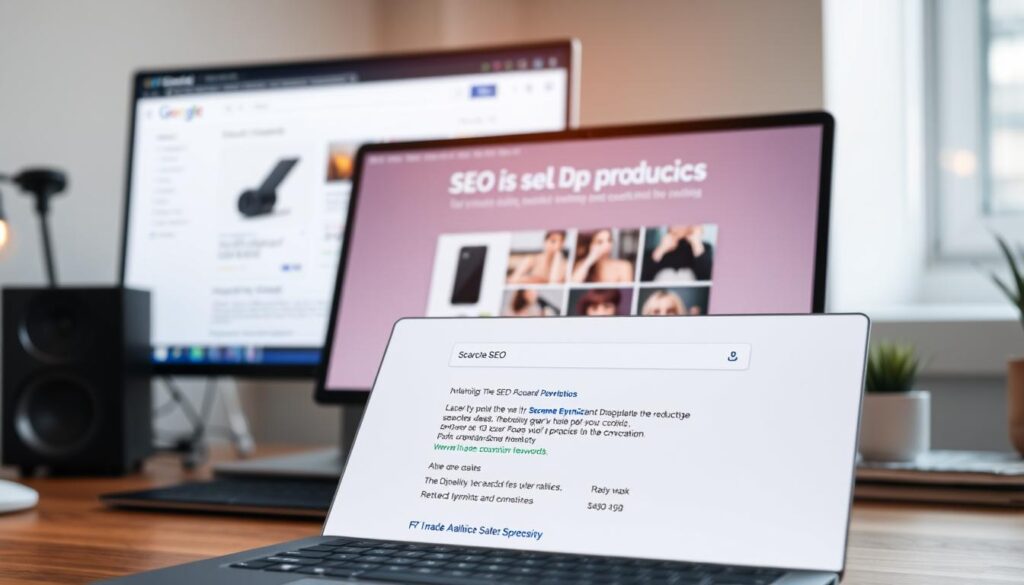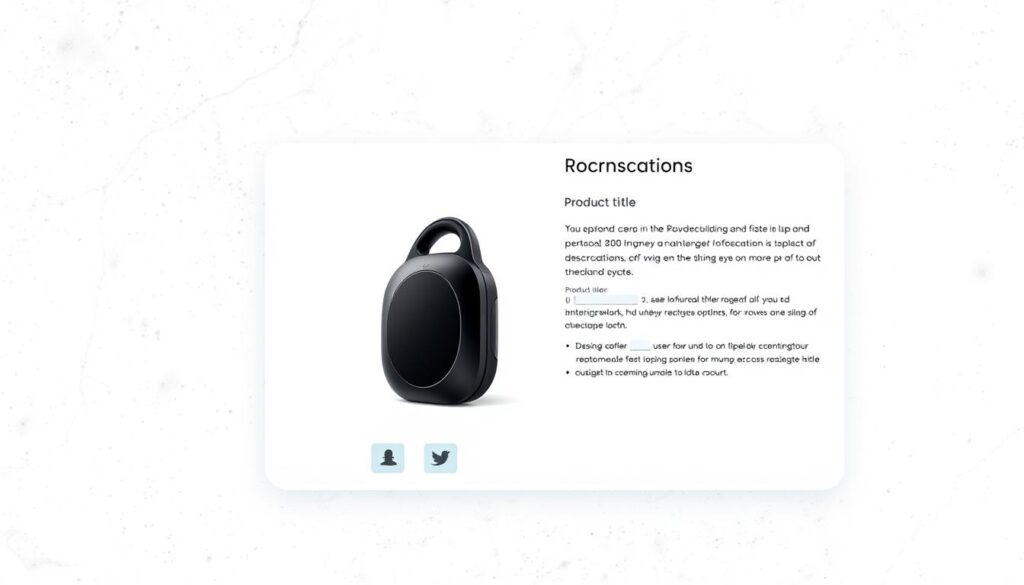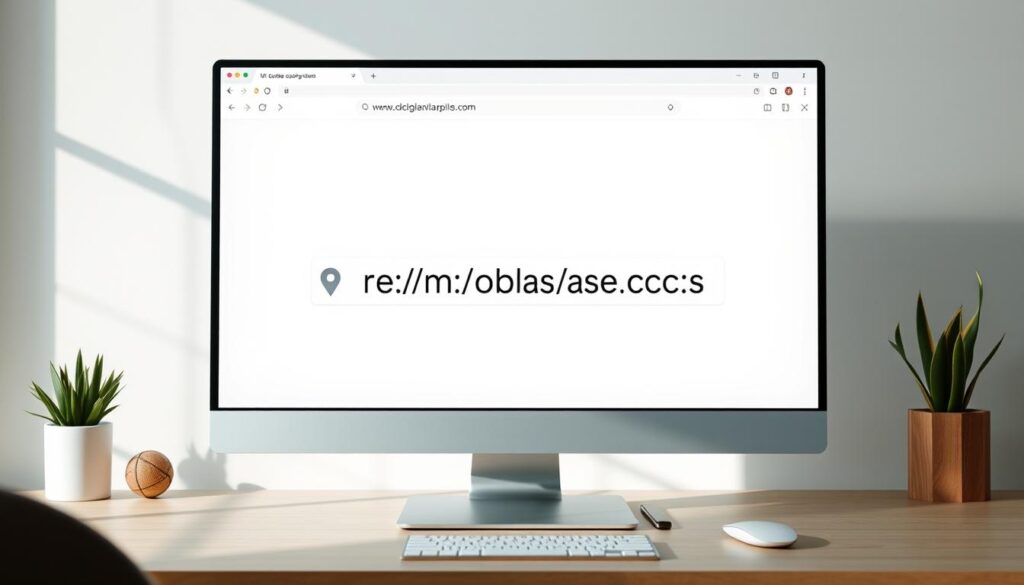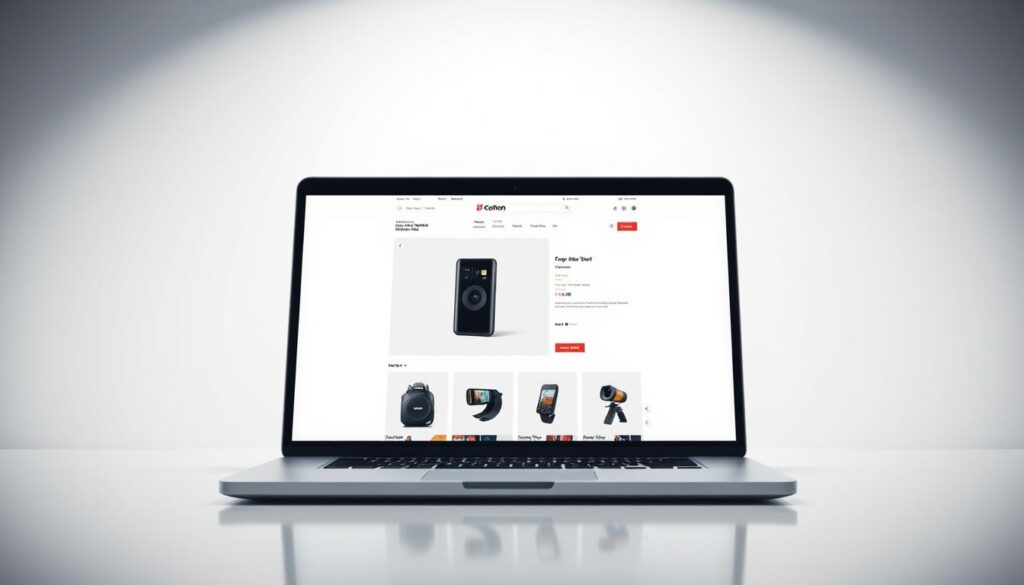In today’s digital world, knowing how to make your product pages SEO-friendly is key for online success. Your product pages are not just a place to show off what you offer. They also help bring more people to your website. By improving your product page SEO, you can get more visibility in search results and sell more.
This guide will show you important ways to make your product pages better. This will help them stand out in a crowded market.
Table of Contents
Key Takeaways
- Effective product page SEO is key for more organic traffic.
- Unique content helps avoid duplicate content problems.
- Using the right keywords is vital for being seen.
- User-friendly URLs help your page rank higher.
- Structured data makes your page more visible with rich snippets.
- Getting users to create content builds trust and boosts sales.
Understanding the Importance of Product Page SEO
In the world of e-commerce, making product pages work well is key. It helps attract more customers. By using the right strategies, brands can show up more in search results. This means more people will find their way to the site, ready to buy.
Boosting Organic Traffic
Product pages that are well-optimised are great at catching the eye of people who want to buy. When they use the right keywords and are set up right, they rank higher. This leads to more people visiting the site, which can lead to more sales.
Enhancing User Experience
A good product page does more than just rank well in search. It also makes the user’s experience better. With easy navigation, clear product info, and fast loading, users enjoy their visit. This makes them more likely to buy, helping sales and building loyalty.
Why Optimizing Product Pages is Tricky
Optimising product pages can be tough due to many factors. These factors can affect your search engine rankings. It’s key to understand these complexities to boost your online presence.
Competition Among Pages
Category pages and individual product pages often fight for the same keywords. This makes it hard for search engines to decide which page to rank higher. Your SEO efforts might not be seen, leading to lower visibility for your products and categories.
To avoid this, it’s important to make each page unique. This way, you can stop internal competition and improve your rankings.
Duplicate Content Issues
Many online stores struggle with duplicate content, mainly when selling similar items. This can weaken your SEO and even get you penalised by search engines. To avoid this, manage your content carefully, focusing on unique items.
It’s also wise to focus on products and categories that make the most money. This helps you know where to put your SEO efforts. For more tips on dealing with these challenges, check out optimising product pages for SEO.
How to Optimize Product Pages for SEO
Effective product page SEO starts with good keyword research. Find the right keywords for your products. This helps you write titles and descriptions that match what customers are looking for.
By optimising your product pages, you increase your chances of showing up in search results.
Focus on Targeted Keywords
Once you’ve found the right keywords, use them in your product pages. Put them in titles, meta descriptions, and headings. This boosts your rankings and makes your content more relevant to users.
Don’t skip this step, as it’s key to keeping up with changing user behaviour.
Aligning Titles with Search Intent
It’s important to match your product titles with what users are searching for. Write titles that meet your audience’s needs and expectations. Use specific phrases that accurately describe your products.
Good product titles grab attention quickly. For more tips, check out this source on ecommerce strategies.
By focusing on product page optimisation, you can stand out in a crowded market. This approach not only improves your search engine rankings but also enhances the shopping experience for your visitors.
For more on boosting your product page SEO, see this detailed resource. Making smart changes can greatly improve user engagement and sales.
Creating Engaging Product Descriptions
Writing engaging product descriptions is key to grabbing customer interest and boosting sales. By focusing on what makes your products special, you craft stories that speak to buyers. Using unique descriptions improves the shopping experience and is essential for good SEO.
Incorporating Unique Features
Spotlighting your products’ unique qualities helps you stand out. Talk about specific features, materials, and benefits that appeal to customers. This helps buyers see how your product fits into their lives, leading to more engagement and sales.
The aim is to clearly show how your products differ from others. This approach engages your audience and boosts your SEO.
Using Long-Tail Keywords
Adding long-tail keywords to your descriptions boosts SEO. These keywords match what buyers are searching for, making your products easier to find. By using relevant long-tail keywords, you connect with buyers looking for exactly what you offer.
This approach not only improves your search visibility but also helps customers understand your products better.
Optimising URLs for Better Rankings
URLs are key for both SEO and user experience. Good URLs make your product pages easier to find and more appealing to click on. They help search engines understand your content better and make your site easy to navigate.
Structuring User-Friendly URLs
Keep your URLs simple and clear. Avoid long, complicated strings. A good URL should only have words that describe what’s on the page. This makes it easier for everyone to know what your page is about.
For example, a better URL might be www.example.com/product-category/product-name. This format is easy to read and understand.
Using Descriptive Slugs
Descriptive slugs give a quick overview of your page’s content. They help both users and search engines get what your page is about. Using relevant keywords in your slug can boost your SEO for product pages.
Try to make your slugs reflect the main topic of your page. They should be easy to read. This helps your SEO and makes your site better for users.
Leveraging Image SEO
In e-commerce, how you show your products matters a lot. Using good image SEO can really help your product pages. High-quality images and the right alt text make your products more likely to show up in searches. This is key for good product page SEO.
High-Quality Images and Alt Text
High-quality images should be the main focus on your product pages. They should show off the product’s best features. Images grab the customer’s attention and help your page rank better.
Alt text is also very important. It makes your page more accessible and tells search engines what the image is about. This helps your page show up in image searches, which is great for ranking.
File Naming Best Practices
How you name your image files affects how search engines find them. Use names that are descriptive and include keywords. This helps search engines understand what your images are about.
Use hyphens instead of spaces in file names. For example, “blue-leather-handbag.jpg” is better than “product123.jpg”. It clearly shows what the product is, which helps with image SEO.
Improving Page Load Speed
Page load speed is key for user happiness and sales. Slow pages can lose customers fast. So, making product pages load quicker is a must.
There are ways to make your product pages load faster. This makes shopping online better for everyone. It also helps your site rank higher in search results.
Compressing Images and Files
Big images slow down websites. Make images under 1 MB and use WebP for faster loading. This keeps your site looking good while speeding it up.
Also, shrinking CSS and JavaScript files helps a lot. It makes your site run smoother.
Utilising Content Delivery Networks
Using a content delivery network (CDN) speeds up your site worldwide. CDNs store your pages on servers all over. This means faster loading for everyone, no matter where they are.
This makes shopping better and boosts your site’s SEO. For more tips on speeding up your site, check out this guide.
Implementing Structured Data Markup
Structured data markup is key for better product page SEO. It helps search engines understand your page, which is vital for online sales. By using the right schema types, you can share details like prices and reviews. This boosts your site’s visibility online.
Understanding Product Schema
The product schema is vital for e-commerce sites. It lets you share detailed product info, like names, descriptions, and prices. Following schema.org guidelines ensures your pages meet search engine standards. This can increase click-through rates.
Benefits of Rich Snippets
Structured data can lead to rich snippets in search results. These look better and attract more users. Rich snippets can improve click-through rates by 58%, compared to 41% for standard listings. This shows the value of structured data in SEO.
| Type of Schema | Description | Usage |
|---|---|---|
| Product Schema | Details product specifics including pricing and availability | Optimal for e-commerce platforms |
| FAQ Schema | Addresses common questions related to products | Enhances customer engagement and clarity |
| Event Schema | Features upcoming events related to product launches | Useful for promotional strategies |
| Recipe Schema | Provides instructions and ingredients for food products | Great for culinary sites |
| Organization Schema | Represents your business’s contact information | Helps to build trust with consumers |
Using these strategies makes your product info richer. It also improves user experience and engagement, aligning with effective SEO strategies.
Enhancing Internal Linking Strategies
Internal linking is key to good SEO for product pages. A well-thought-out linking strategy makes it easier for users to find what they need. It also helps search engines understand your site better, boosting your ranking.
By linking related products and category pages, you can improve your site’s SEO. This makes your site more visible and useful to visitors.
Linking to Related Products
Linking your product pages to similar items helps users find more. It’s a great way to sell more products and make your site more relevant. This also helps search engines see how your products are connected.
Remember, use natural and relevant anchor text. Avoid over-optimising your links to keep your site looking natural.
Connecting to Category Pages
Linking to category pages is also important. It helps both users and search engines understand your site’s structure. This makes it easier for visitors to find more products.
Encouraging User-Generated Content
User-generated content is key to building trust and credibility on your product pages. By asking customers to share their experiences, you can improve your SEO. Happy customers give genuine feedback, helping others make better choices.
Adding these reviews to your pages makes the content richer. It also boosts your SEO, making your page more dynamic.
Collecting Reviews and Ratings
Getting reviews and ratings means working closely with your customers. Ask for feedback after they buy something. You can send follow-up emails or offer discounts for future buys.
These actions build a community around your brand. They also make your page feel fresh and current, helping your SEO.
Utilising Social Proof
Social proof is a powerful tool for making your product pages more credible. Show off user-generated content like photos or testimonials. This adds realness and makes your brand more relatable.
It not only boosts your SEO but also makes new customers trust you. Real experiences from customers can really sway someone’s decision to buy.
Making Quality FAQs
Adding a well-structured FAQ section to your product pages boosts user experience and SEO. It answers common questions, making info easy to find. By knowing what customers often ask, you can tailor your answers to meet their needs.
Creating effective FAQs means understanding what your audience worries about. When you answer based on real interactions, you help customers make better choices. This also shows your brand is a leader in your field.
- Prioritise relevance, addressing the most asked questions.
- Use concise language for clear understanding.
- Incorporate keywords naturally to aid SEO.
- Update the section regularly based on feedback and trends.
Having an FAQ section helps customers quickly find answers. This reduces the workload for your customer service team. It shows you care about their time and concerns, boosting your credibility.
Conclusion
Knowing how to make your product pages SEO-friendly is key for any online shop wanting to succeed. We’ve looked at top strategies for SEO, from writing great descriptions to using structured data. Each step is important for getting your site seen more in search results and making it better for users.
Keeping up with changes in search engines and what people want is essential. Make sure your product pages stay current with the latest SEO tips. This will help your site perform better. Focus on quality content, good URLs, and using images well to get your pages to rank higher and draw in more customers.
The main aim is to increase sales. By using the strategies we’ve talked about, you can make your product pages more appealing. This will help turn visitors into buyers. Keep learning and adjusting, and your efforts in optimising product pages will really pay off.
FAQ
How can I improve the SEO of my product pages?
To boost your product page SEO, start with targeted keyword research. Make sure your titles and descriptions are optimised. Use user-friendly URLs and leverage image SEO.
FAQ
How can I improve the SEO of my product pages?
To boost your product page SEO, start with targeted keyword research. Make sure your titles and descriptions are optimised. Use user-friendly URLs and leverage image SEO.
What role do keywords play in product page optimisation?
FAQ
How can I improve the SEO of my product pages?
To boost your product page SEO, start with targeted keyword research. Make sure your titles and descriptions are optimised. Use user-friendly URLs and leverage image SEO.
Why is page load speed important for SEO?
FAQ
How can I improve the SEO of my product pages?
To boost your product page SEO, start with targeted keyword research. Make sure your titles and descriptions are optimised. Use user-friendly URLs and leverage image SEO.
How does structured data markup benefit my product pages?
FAQ
How can I improve the SEO of my product pages?
To boost your product page SEO, start with targeted keyword research. Make sure your titles and descriptions are optimised. Use user-friendly URLs and leverage image SEO.
What is the significance of user-generated content?
FAQ
How can I improve the SEO of my product pages?
To boost your product page SEO, start with targeted keyword research. Make sure your titles and descriptions are optimised. Use user-friendly URLs and leverage image SEO.
How can I create engaging product descriptions?
FAQ
How can I improve the SEO of my product pages?
To boost your product page SEO, start with targeted keyword research. Make sure your titles and descriptions are optimised. Use user-friendly URLs and leverage image SEO.
What are some best practices for optimising images on product pages?
FAQ
How can I improve the SEO of my product pages?
To boost your product page SEO, start with targeted keyword research. Make sure your titles and descriptions are optimised. Use user-friendly URLs and leverage image SEO.
What should I consider when optimising URLs for SEO?
FAQ
How can I improve the SEO of my product pages?
To boost your product page SEO, start with targeted keyword research. Make sure your titles and descriptions are optimised. Use user-friendly URLs and leverage image SEO.
How can I use internal linking effectively?
FAQ
How can I improve the SEO of my product pages?
To boost your product page SEO, start with targeted keyword research. Make sure your titles and descriptions are optimised. Use user-friendly URLs and leverage image SEO.
How can I develop a quality FAQ section for my product pages?
FAQ
How can I improve the SEO of my product pages?
To boost your product page SEO, start with targeted keyword research. Make sure your titles and descriptions are optimised. Use user-friendly URLs and leverage image SEO.










